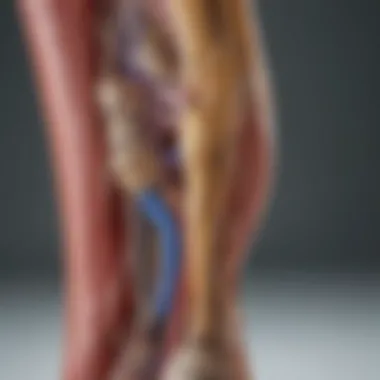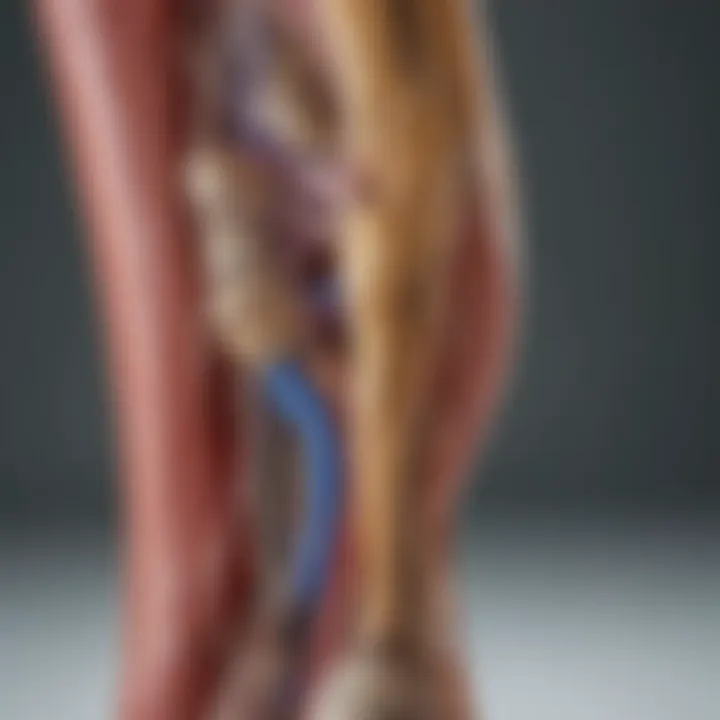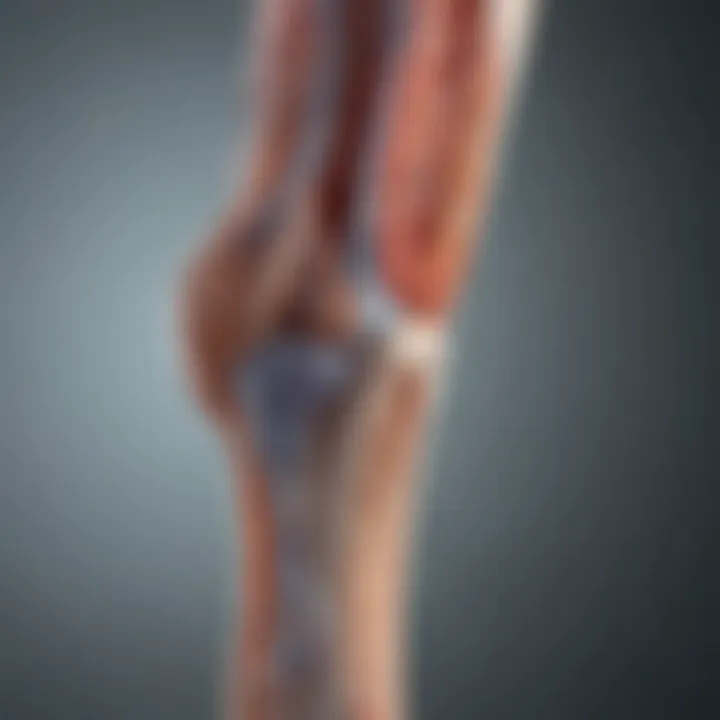Understanding Sciatica and Its Impact on Ankle Health


Intro
Sciatica is a condition that often leads to discomfort and pain, primarily affecting the lower back and legs. However, its implications may extend beyond these areas. This article delves into the intricate relationship between sciatica and ankle health. Understanding how sciatica might manifest in ankle pain can enhance both diagnosis and treatment strategies.
By linking anatomical connections and neurological pathways, we explore how the symptoms of sciatica can influence the ankle's function. A clear grasp of these associations can benefit medical professionals, students, and researchers alike, paving the way for improved treatment options and enhanced patient outcomes.
Key Findings
- Sciatica is commonly associated with pain radiating through the back and legs, but it can significantly affect the ankle region as well.
- The anatomical connections between the sciatic nerve and the structures surrounding the ankle are key to understanding this relationship.
- Symptoms may include numbness, tingling, and weakness in the ankle, often complicating the clinical picture.
Summary of the main results
Research indicates that the sciatica affects not only the areas directly supplied by the sciatic nerve but also other regions through compensatory mechanisms. When the lower back is compromised, the body tends to alter movement patterns, leading to stress on the ankle. This can culminate in pain or dysfunction.
Significance of findings within the scientific community
The findings present an opportunity for further study in both neurology and orthopedics. Understanding these connections can foster interdisciplinary approaches in treatment, leading to better care models for individuals suffering from sciatica.
Implications of the Research
Applications of findings in real-world scenarios
Recognizing the link between sciatica and ankle pain allows healthcare providers to develop more effective treatment plans. For instance, tailored physiotherapy regimens can address both the symptoms of sciatica and the resultant ankle discomfort. This is crucial for athletes and patients with active lifestyles who cannot afford prolonged recovery times.
Potential impact on future research directions
Further exploration into this relationship could lead to novel therapeutic techniques and interventions. Investigating the interactions between neurological pathways and musculoskeletal responses will likely refine existing models in both rehabilitation sciences and pain management strategies.
Understanding the relationship between sciatica and ankle health is essential. It can lead to early diagnosis and appropriate treatment strategies.
Preamble to Sciatica
Sciatica is not merely a term used to describe pain; it encompasses a broader spectrum of symptoms and implications. Understanding this condition is essential for recognizing its subtle yet profound effects that can extend beyond the lower back to various regions, including the ankle. This section lays the groundwork for comprehending not only the definition and implications of sciatica but also its significance within the context of overall health.
The relevance of sciatica emerges from its potential to impact daily life. Individuals experiencing sciatica may encounter challenges in mobility and physical tasks, leading to reduced quality of life. Recognizing these impacts early can facilitate timely interventions, which may prevent further complications.
Definition of Sciatica
Sciatica refers to the pain that travels along the path of the sciatic nerve, which is the longest nerve in the body. It branches from the lower back through the hips and buttocks and down each leg. When this nerve is compressed or irritated, a person may experience pain that varies from mild to debilitating. The pain can radiate along the nerve pathway, sometimes reaching the ankle. Symptoms can also include numbness, tingling, and weakness, significantly affecting an individual's ability to perform daily activities.
Prevalence and Demographics
Sciatica is a common condition that affects a significant portion of the population. Studies estimate that around 40% of people will experience sciatica at some point in their lives. The prevalence rates vary across different age groups, often peaking among individuals aged 30 to 50. Factors such as lifestyle, occupation, and overall physical health play crucial roles in the likelihood of developing sciatica.
Some demographic factors influencing the occurrence of sciatica include:
- Age: Older adults often experience degeneration of the discs in the spine, leading to nerve compression.
- Occupational Hazards: Jobs involving heavy lifting or prolonged sitting heighten the risk.
- Lifestyle Choices: Sedentary lifestyles, obesity, and lack of exercise contribute to the development of conditions associated with sciatica.
As awareness of these aspects grows, a detailed understanding of sciatica becomes imperative for potential prevention and effective management, particularly in relation to ankle implications.
Anatomy of the Sciatic Nerve
Understanding the anatomy of the sciatic nerve is crucial for exploring its implications on ankle health. The sciatic nerve is the longest nerve in the body, playing a significant role in the lower limb's function. It originates from the lumbosacral plexus and extends through the pelvis down the back of the leg. Its complexity is noteworthy because any irritation or damage to it can manifest in various ways, including pain, tingling, and weakness, especially affecting the ankle and foot. Understanding this anatomy helps in diagnosing conditions related to sciatica effectively and devising appropriate treatment plans.
Origin of the Sciatic Nerve


The sciatic nerve originates from the lower spinal cord, specifically from the lumbar and sacral nerve roots (L4-S3). This origin is important because it highlights the nerve's connection to the spinal column. When the spinal roots are compressed or irritated, it can lead to symptoms of sciatica. These issues might arise from various factors such as herniated discs or degenerative disk disease. Thus, the origin of the sciatic nerve illustrates how closely linked the spine and the leg are, providing a foundation for understanding how pain can radiate to the ankle.
Pathway of the Sciatic Nerve
After its origin, the sciatic nerve travels through the greater sciatic notch of the pelvis and into the gluteal region. It then runs down the posterior aspect of the thigh. This pathway is significant for several reasons. First, during its journey, the nerve passes close to various muscles and bones, posing a risk of compression or irritation. Second, understanding this pathway is essential for identifying potential injury sites. For instance, if the nerve becomes entrapped by gluteal muscles or soft tissues, it can lead to sciatica symptoms that may include pain or numbness in the ankle region.
Branches and Innervation
The branches of the sciatic nerve contribute to innervating major muscle groups in the leg. It's mainly divided into two branches: the tibial nerve and the common fibular nerve. The tibial nerve innervates muscles in the calf and the sole of the foot, which are critical for ankle function. Meanwhile, the common fibular nerve further branches into the superficial and deep fibular nerves, controlling the foot's movement. Understanding these branches is key in observing the interconnectedness of pain and dysfunction experienced in the ankle.
Understanding the anatomy and function of the sciatic nerve provides insight into potential sources of ankle pain and creates a foundation for diagnosis and treatment.
Understanding Sciatica Symptoms
The understanding of sciatica symptoms is crucial in this discussion because they provide foundational insights into how this condition affects individuals. Symptoms can vary in nature and intensity, influencing both diagnosis and treatment strategies. Recognizing these symptoms is essential for accurate assessments and interventions, especially when the discomfort is perceived in distal regions such as the ankle. By understanding the array of symptoms associated with sciatica, healthcare professionals can avoid misdiagnosis and tailor more effective treatment plans for their patients.
Common Symptoms of Sciatica
Sciatica manifests through various symptoms, which are often distinctive to the condition itself. Some of the most commonly reported symptoms include:
- Pain: Typically felt in the lower back, buttocks, and radiating down one leg. The pain may range from mild to severe.
- Numbness or Tingling: Patients often report sensations similar to pins and needles, usually localized in the leg or foot.
- Muscle Weakness: Difficulty in moving the affected leg, which may lead to challenges in walking or performing daily activities.
- Radiating Pain: Pain that travels down the leg, sometimes reaching the foot, which is a hallmark of sciatica.
It is important to note that these symptoms may not always appear together, and their presence can vary in duration and intensity. Furthermore, activities that put pressure on the spine, such as sitting for extended periods, may exacerbate these symptoms.
Symptoms Specific to the Ankle Region
In some cases, individuals experiencing sciatica may also encounter symptoms localized to the ankle region. These symptoms can be especially perplexing, as the source, sciatica, may be perceived distant from the ankle itself. Specific symptoms in this area can include:
- Localized Pain: Discomfort or pain right around the ankle joint that may be mistaken for a separate issue.
- Swelling: Inconsistent swelling that might appear in tandem with other symptoms of sciatica.
- Focal Tenderness: Increased sensitivity when pressure is applied to certain areas around the ankle.
- Restricted Range of Motion: Difficulty in moving the ankle, potentially affecting walking or other physical activities.
Understanding these symptoms is vital. They can often be overlooked or attributed to other conditions such as sprains or strains. Hence, it is imperative that medical professionals consider the potential connection to sciatica during the evaluation process.
Recognizing the range of symptoms associated with sciatica can lead to more precise diagnosis and effective treatment, especially when symptoms reach the ankle.
Grasping the full spectrum of sciatica symptoms not only benefits the healthcare provider but also empowers individuals to seek timely and appropriate care.
Link Between Sciatica and Ankle Pain
Understanding the connection between sciatica and ankle pain is crucial in addressing both conditions effectively. Many individuals experiencing ankle discomfort may not realize it is linked to sciatica. Recognizing this relationship can significantly improve diagnostic accuracy and treatment strategies. With a proper understanding of how these two issues intersect, both clinicians and patients can work towards finding solutions that address more than just the symptoms.
Neurological Pathways
The sciatic nerve is the largest nerve in the body and runs from the lower back down through the legs to the feet. When this nerve is compressed or irritated, it can result in pain that radiates from the lower back down to various areas, including the ankles. The neurological pathways involved are intricate, as the sciatic nerve branches out significantly. This branching allows for overlapping areas of sensation, meaning that irritation at one point can manifest discomfort in seemingly unrelated regions.
In addition to pain, individuals may experience tingling or numbness in the ankle. This sensation occurs because the nerve impulses can become disrupted. Structural issues, such as herniated discs or spinal stenosis, may contribute to these symptoms, affecting how the nervous system communicates with the ankle area.
Key elements to consider include:
- The impact of spinal alignment on nerve function.
- The role of inflammation in exacerbating symptoms.
- How specific physical activities can aggravate or relieve discomfort.
Referred Pain Mechanisms
Referred pain is a phenomenon where pain is perceived at a location different from its source. The relationship between sciatica and ankle pain exemplifies this concept well. As the sciatic nerve travels through the body, it can send signals that the brain interprets as originating from the ankle, despite the actual source being in the lower back.
Several mechanisms may contribute to referred pain:


- Nerve compression: Compression of the sciatic nerve can lead to pain signals misinterpreted by the brain.
- Muscle tension: Tight or strained muscles in the lower back can create sensations felt in the ankle, complicating the diagnosis.
- Inflammation: Conditions like sciatica often result in inflammation, which can activate pain receptors in other parts of the body, including the ankles.
"Recognizing referred pain is essential for accurate diagnosis and treatment. Every layer of pain experience demands a thoughtful approach to care."
Awareness of these mechanisms helps in forming a comprehensive treatment plan. By addressing both the source and related symptoms, patients may achieve a more holistic recovery. Identifying the relationship between sciatica and ankle pain allows healthcare providers to offer targeted therapies that can make a significant impact.
Diagnosis of Sciatica Affecting the Ankle
Diagnosing sciatica, particularly when it affects the ankle, is crucial for effective treatment and management. Sciatica usually arises due to compression or irritation of the sciatic nerve, and identifying the root cause of the pain can be complex. Accurate diagnosis ensures that any underlying issues are addressed. By taking the time to evaluate both the neurological and orthopedic aspects, healthcare providers can tailor treatment plans that meet individual needs. The implications for mobility and quality of life necessitate a thoughtful approach to this diagnosis.
Clinical Assessment Techniques
Clinical assessment is the primary method for diagnosing sciatica. It involves a thorough evaluation of the patient's history and physical examination. Physicians often begin by asking about pain characteristics—its onset, duration, and intensity, along with associated symptoms such as numbness or tingling.
The following diagnostic techniques may be employed:
- Neurological Examination: This includes testing reflexes, muscle strength, and sensory response. The aim is to detect any signs of nerve damage.
- Straight Leg Raise Test: This test evaluates the nerve's response when the leg is lifted. Pain during this test can indicate sciatica.
- Palpation: Examining underlying muscle and joint tenderness is necessary to distinguish between localized ankle issues and nerve-related pain.
These techniques provide essential information that guides further diagnostic imaging if needed.
Imaging Studies and Their Relevance
While clinical assessments provide valuable insight, imaging studies often play a necessary role in confirming a diagnosis and evaluating the extent of nerve involvement. Commonly used imaging methods include:
- Magnetic Resonance Imaging (MRI): This method is ideal for visualizing soft tissue structures. It can highlight any herniated discs or spinal stenosis affecting the sciatic nerve.
- Computed Tomography (CT) Scan: CT scans offer a detailed view of the spine and can help identify bone abnormalities alongside soft tissue issues.
- X-rays: Though not as detailed as CT or MRI, X-rays can be useful to rule out fractures or structural issues in the spine.
Research indicates that the combination of clinical assessment and imaging studies increases the likelihood of reaching an accurate diagnosis. This synergetic approach can lead to more effective treatment strategies which address both sciatica and its impact on the ankle.
Overall, the diagnosis of sciatica affecting the ankle is a multi-faceted process. It requires both thorough clinical evaluation and the judicious use of imaging to ensure that practitioners can provide appropriate and effective care.
Treatment Options for Sciatica-Related Ankle Pain
Effective management of sciatica that affects the ankle is essential for patients experiencing discomfort and mobility challenges. Understanding the various treatment pathways helps patients and practitioners navigate care options. Treatment strategies can range from conservative measures to more invasive procedures, depending on the severity of symptoms and individual patient factors. Choosing the right intervention is crucial for alleviating pain and improving functionality in daily life.
Conservative Management Strategies
Conservative management often serves as the first line of treatment for sciatica-related ankle pain. This approach focuses on non-invasive methods to reduce pain and enhance mobility. Key strategies include:
- Pain Relief Medications: Non-steroidal anti-inflammatory drugs (NSAIDs), such as ibuprofen, can help manage pain and inflammation. Acetaminophen is another alternative for those who may not tolerate NSAIDs well.
- Activity Modification: Limiting activities that exacerbate pain is important. Gentle exercise, such as walking or swimming, may be recommended, while high-impact activities should be avoided until symptoms improve.
- Heat and Cold Therapy: Applying a cold pack can minimize swelling, while heat therapy helps restore blood flow and relaxes tense muscles.
These strategies often require adjustment based on individual responses to treatment. Close monitoring by a healthcare professional is essential to determine effectiveness and make necessary modifications.
Physical Therapy Approaches
Physical therapy plays a pivotal role in recovery for individuals experiencing sciatica-related ankle pain. Tailored physical therapy programs can help strengthen supporting muscles, improve flexibility, and promote proper posture. Common physical therapy approaches include:
- Stretching Exercises: Targeted stretches can alleviate tightness in the back and leg muscles, potentially reducing pressure on the sciatic nerve and mitigating pain.
- Strengthening Exercises: A focus on core and lower body strengthening is beneficial for providing stability and support. Exercises may include bridges, squats, and resistance training.
- Manual Therapy: Hands-on techniques by a physical therapist, including spinal manipulations and mobilizations, can alleviate tus tension and facilitate better movement.
Engagement in a physical therapy regimen not only targets pain but also enhances overall physical health and functionality. Progress should be regularly assessed to refine exercise techniques and ensure optimal outcomes.
Surgical Interventions
In cases where conservative measures and physical therapy do not yield satisfactory results, surgical interventions may be considered. Surgery is typically seen as a last-resort option and comes with associated risks.
- Microdiscectomy: This procedure involves the removal of herniated disc material pressing on the sciatic nerve. It aims to relieve pain and improve mobility.
- Laminectomy: This broader procedure entails removing a portion of the vertebra to alleviate pressure on the spinal nerves, which can lead to pain relief in the ankle region.
- Spinal Fusion: In select cases, spinal fusion may be recommended to stabilize the spine, particularly if there is structural instability contributing to nerve compression.


Surgical decisions need thorough evaluation and discussion between the patient and healthcare provider. Assessing factors like the severity of symptoms, overall health, and specific anatomical considerations will aid in making informed choices.
Surgical options should always be considered carefully and discussed in detail with a specialist.
In summary, navigating treatment options for sciatica-related ankle pain requires a comprehensive understanding of both conservative and surgical interventions. By exploring these pathways, patients can work towards improved quality of life and increased physical mobility.
Preventive Measures for Sciatica
Preventing sciatica is crucial for maintaining overall health and reducing the risk of ankle-related complications. The implications of sciatica extend beyond the lower back and can lead to discomfort and reduced mobility in the legs and ankles. Proper preventive measures can help mitigate these effects, allowing individuals to maintain an active lifestyle.
Lifestyle Modifications
Making specific changes in daily habits can significantly reduce the risk of developing sciatica. Here are some key modifications to consider:
- Posture Awareness: Maintaining proper posture while sitting and standing helps align the spine and reduces pressure on the sciatic nerve.
- Ergonomic Furniture: Utilizing ergonomic chairs and desks can provide necessary support during long periods of sitting.
- Weight Management: Keeping a healthy weight decreases strain on the back and spine, reducing the likelihood of nerve compression.
- Smoking Cessation: Quitting smoking can enhance blood circulation and reduce the risk of degenerative disk disease, which can lead to sciatica.
Incorporating these lifestyle changes is not merely a preventive strategy but a means to improve overall physical well-being. By being proactive, one can significantly decrease the chances of nerve-related issues.
Exercises to Strengthen the Back and Legs
Engaging in regular exercise is another key preventive measure. Strengthening exercises for the back and legs can play a vital role in supporting the spine and alleviating pressure on the sciatica nerve. Recommended exercises include:
- Core Strengthening: Engaging in exercises that target the abdominal muscles, such as planks or bridges, helps stabilize the spine and support proper posture.
- Leg Raises: This is effective for strengthening the hip flexors and improving balance. It is crucial for supporting the hips and back.
- Stretching Exercises: Regular stretching of the hamstrings and glutes can improve flexibility and reduce tension that contributes to sciatica.
- Low-Impact Aerobic Activities: Activities like walking, swimming, or cycling enhance cardiovascular fitness and promote blood flow, indirectly supporting spinal health.
These exercises should be performed consistently. While beginning any new exercise regime, it is wise to consult with healthcare professionals, particularly if there is any existing back pain or discomfort.
"Prevention is always better than cure. Implementing preventive measures for sciatica can save one from a slew of complications down the line."
In summary, preventive measures such as lifestyle modifications and strengthening exercises are essential for avoiding sciatica and its implications for ankle health. These practices contribute to better physical health and enhance quality of life.
Long-term Outlook for Individuals with Sciatica
Understanding the long-term outlook for individuals with sciatica provides vital insight into both the condition and its impact on daily life, particularly considering how it relates to ankle health. The prognosis for sciatica can vary significantly from one person to another based on the underlying causes, the effectiveness of treatment, and the overall health of the individual. In this section, we will break down the key elements influencing prognosis and recovery, as well as factors that may impact an individual’s journey toward regaining full mobility and function.
Prognosis and Recovery
The prognosis for those suffering from sciatica, especially when it relates to the ankle, can be generally positive. Many individuals experience significant improvements within a few weeks or months, with 60-80% reporting alleviation of symptoms with appropriate treatment. Factors contributing to a favorable prognosis often include:
- Early Intervention: Starting treatment promptly can lead to better outcomes.
- Adherence to Treatment Plans: Following prescribed therapeutic exercises and medications diligently aids in recovery.
- Physical Health Factors: The overall fitness of an individual influences recovery speed and effectiveness.
Recovery may involve managing pain, restoring movement, and supporting the affected areas, including the ankle. Although some may experience recurring symptoms, effective management strategies can minimize flare-ups and enhance quality of life.
Factors Influencing Recovery
Several factors play a role in how well an individual recovers from sciatica:
- Nature of the Underlying Condition: Conditions like herniated discs or spinal stenosis can complicate recovery, while more benign causes might facilitate quicker healing.
- Patient Age: Younger individuals often recover more quickly compared to older patients due to higher resilience and fewer comorbidities.
- Lifestyle Choices: Regular exercise, a balanced diet, and maintaining a healthy body weight can promote better healing outcomes.
- Psychosocial Elements: Mental health can significantly affect recovery. Stress, anxiety, and depression can hinder progress.
"The road to recovery is often intricate, but understanding its dynamics can empower individuals to take active roles in their healing."
Overall, acknowledging the variables that impact recovery can aid healthcare providers in tailoring more personalized treatment plans. For patients, this understanding can instill a sense of control over their condition and a more optimistic outlook on effective healing and future mobility.
Closure
The examination of sciatica in relation to ankle health illuminates vital connections that are often overlooked. Understanding these implications not only assists individuals suffering from sciatica but also provides insights for healthcare providers. The complexities involved in sciatica, particularly regarding symptoms that manifest in the ankle, underscore the importance of a comprehensive approach to diagnosis and treatment.
Summary of Key Points
- Sciatica arises from irritation or compression of the sciatic nerve, which travels from the lower back down through the legs.
- Symptoms may not be limited to the traditional areas; individuals can experience pain, numbness, or weakness in the ankle region.
- The link between neurological pathways and referred pain mechanisms is critical for understanding how sciatica affects the ankle.
- Diagnostic techniques, including clinical assessments and imaging studies, play a pivotal role in accurately identifying the source of ankle pain related to sciatica.
- Treatment options range from conservative management to surgical interventions, highlighting the necessity for a tailored approach based on individual patient needs.
- Preventive measures, including lifestyle modifications and targeted exercises, are essential in mitigating the onset of sciatica and its repercussions on the ankle.
- Long-term prognosis for individuals with sciatica affecting the ankle is influenced by various factors, making ongoing assessment and management crucial.
By recognizing the multifaceted nature of sciatica, medical professionals can offer more effective care strategies. Additionally, individuals can become better informed of their condition, leading to more proactive management of their health.







